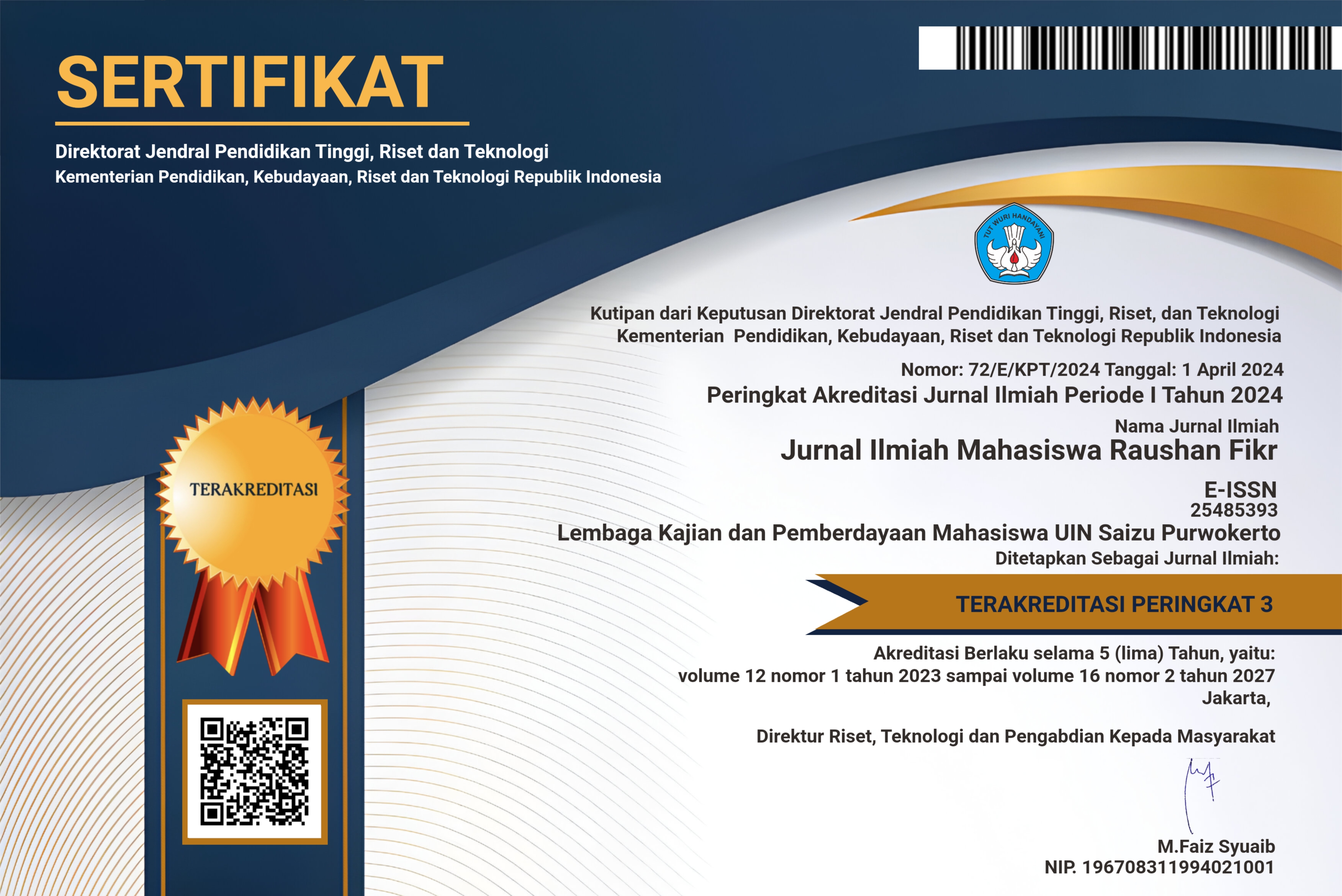ETIKA KOMUNIKASI DI MEDIA SOSIAL: KAJIAN AL-QURAN SURAT AN-NUR AYAT 11-15
DOI:
https://doi.org/10.24090/jimrf.v13i2.11932Kata Kunci:
etika komunikasi, social media, Q.S An-Nur ayat 11-15Abstrak
Dunia modern saat ini berbeda dengan sebelumnya yang dapat dilihat dari berbagai bidang kehidupan manusia. Perkembangan di bidang komunikasi dan informasi saat ini membuat dunia yang luas ini seolah-olah kecil. Artinya manusia dapat berkomunikasi dan mendapatkan informasi secara global tanpa terbatas pada ruang dan waktu. Kehadiran internet sebagai media komunikasi baru dalam masyarakat mempunyai dampak baik dan buruk bagi kehidupan. Penelitian ini bertujuan untuk: mengetahui bagaimana penafsiran QS An-Nur/24: 11-15, mengetahui kandungan QS An-Nur/24:11-15 tentang etika komunikasi bermedia sosial dan untuk mengetahui bagaimana penerapan etika komunikasi bermedia sosial di internet dalam QS An-Nur/24:11-15. Jenis penelitian ini termasuk dalam penelitian library research dan termasuk dalam penelitian kualitatif. Pengumpulan data dilakukan dengan menelaah referensi-referensi yang terkait dengan topik pembahasan. Dengan sumber rujukan pertama yaitu al-Qur’an karena ayatnya yang menjadi inti pembahasan dalam penelitian. Kandungan nilai-nilai etika komunikasi yang terdapat dalam QS An-Nur/24: 11-15 di dapat beberapa poin yaitu: (1) berkata baik, (2) bersikap jujur dan (3) keakurasian informasi (tabayyun). Nilai-nilai etika komunikasi pada QS An-Nur/24: 11-15 tersebut memiliki urgensi dalam kehidupan. Nilai-nilai mengantarkan pada kehidupan bermasyarakat yang damai dan harmonis dalam lingkup komunikasi. Dan penerapan nilai-nilai etika komunikasi pada QS An-Nur/24: 11-15 menjadi petunjuk bagi para pengguna media sosial agar menggunakan media sosial secara bijak. Berkata baik, bersikap jujur dan keakurasian informasi/tabayyun dalam bermedia sosial merupakan cara mengimplementasikan nilai-nilai etika komunikasi dalam QS An-Nur/24: 11-15. Penelitian tentang Etika Komunikasi Bermedia Sosial dalam al-Qur’an (Kajian Tahlili QS An-Nur/24: 11-15) ini berimplikasi pada pentingnya pemahaman tentang etika dalam bermedia sosial menurut al-Qur’an. Maka dari itu, direkomendasikan agar konsep etika komunikasi bermedia sosial dalam al-Qur’an yang telah dibahas dalam skripsi ini dapat dikembangkan pembahasannya serta dapat dijadikan rujukan dalam mengkaji masalah tentang etika komunikasi bermedia sosial perspektif al-Qur’an dengan berbagai pendekatan yang digunakan.Unduhan
Referensi
Aboulkacem, A.R. 2021. “Photovoice 2.0: A Comprehensive Research Framework for the Digital Generation.” TechTrends 65, no. 5: 874–83. https://doi.org/10.1007/s11528-021-00642-4.
Ahmed, O.H. 2020. “The Need for Speed! 10 Ways That WhatsApp and Instant Messaging Can Enhance Communication (and Clinical Care) in Sport and Exercise Medicine.” British Journal of Sports Medicine 54, no. 19: 1128–29. https://doi.org/10.1136/bjsports-2019-101707.
Bain, L.E. 2022. “Community Engagement in Research in Sub-Saharan Africa: Current Practices, Barriers, Facilitators, Ethical Considerations and the Role of Gender - a Systematic Review.” The Pan African Medical Journal 43, no. Query date: 2024-07-05 11:32:57: 152–152. https://doi.org/10.11604/pamj.2022.43.152.36861.
Busl, K.M. 2021. “Use of Social Media in Health Care - Opportunities, Challenges, and Ethical Considerations: A Position Statement of the American Academy of Neurology.” Neurology 97, no. 12: 585–94.
Chen, Y. 2023. “Using Social Media Images as Data in Social Science Research.” New Media and Society 25, no. 4: 849–71.
Chong, W.K. 2023. “The Value of Integrity: Empowering SMEs with Ethical Marketing Communication.” Sustainability (Switzerland) 15, no. 15.
Diekman, C. 2023. “Misinformation and Disinformation in Food Science and Nutrition: Impact on Practice.” Journal of Nutrition 153, no. 1: 3–9.
Ennis-O-Connor, M. 2020. “Social Media Networks and Leadership Ethics in Healthcare.” Healthcare Management Forum 33, no. 3: 145–48.
Hoare, E, K Milton, C Foster, and ... 2016. “The Associations between Sedentary Behaviour and Mental Health among Adolescents: A Systematic Review.” … Journal of Behavioral …, no.
Janah, Futihatul, and Apriyadi Yusuf. 2021. “Etika Komunikasi di Media Sosial Melalui Prinsip SMART (Salam, Ma’ruf, dan Tabayyun) Perspektif Al-Qur’an.” JAWI 3, no. 2 (January).
Karakas, F. 2010. “Exploring Value Compasses of Leaders in Organizations: Introducing Nine Spiritual Anchors.” Journal of Business Ethics 93, no. Query date: 2024-06-08 11:25:30: 73–92. https://doi.org/10.1007/s10551-010-0627-6.
Kinsella, S. 2022. “A Public Dialogue to Inform the Use of Wider Genomic Testing When Used as Part of Newborn Screening to Identify Cystic Fibrosis.” International Journal of Neonatal Screening 8, no. 2. https://doi.org/10.3390/ijns8020032.
Martinho, G. 2017. “Consumer Behavior with Respect to the Consumption and Recycling of Smartphones and Tablets: An Exploratory Study in Portugal.” Journal of Cleaner Production 156, no. Query date: 2024-06-10 16:55:18: 147–58. https://doi.org/10.1016/j.jclepro.2017.04.039.
Muhammadiyah, Tim Majelis Tarjih dan Tajdid PP Muhammadiyah. 2015. Fikih Informasi: Persfektif Majelis Tarjih Muhammadiyah. Yogyakarta: Majelis Tarjih dan Tajdid PP Muhammadiyah.
Niki Alma Febriana Fauzi. 2019. “Nalar Fikih Baru Muhammadiyah: Membangun Paradigma Hukum Islam Yang Holistik.” Afkaruna 15, no. 1. https://doi.org/10.1896/AIIJIS.2019.0094.32-54.
Reese, SS. 2021. “Local and Global Interactions.” Routledge Handbook of Islam in Africa, no. Query date: 2023-11-24 14:54:47.
Rinwanto, Rinwanto, Hidayatus Sholihah, Nurul Hakim, and Mufid Syakhlani. 2021. “Etika Komunikasi Dalam Media Sosial Sesuai Tuntutan Al-Qur An.” Journal of Communication Studies 1, no. 01 (February): 49–61.
Unduhan
Diterbitkan
Cara Mengutip
Terbitan
Bagian
Lisensi
Hak Cipta (c) 2024 Nur Aisyah, Hasyimsah Nasution

Artikel ini berlisensiCreative Commons Attribution-NonCommercial-ShareAlike 4.0 International License.
Authors who publish with this journal agree to the following terms:
- Authors retain copyright and grant the journal right of first publication with the work simultaneously licensed under a Creative Commons Attribution-NonCommercial-ShareAlike 4.0 International License that allows others to share the work with an acknowledgement of the work's authorship and initial publication in this journal.
- Authors are able to enter into separate, additional contractual arrangements for the non-exclusive distribution of the journal's published version of the work (e.g., post it to an institutional repository or publish it in a book), with an acknowledgement of its initial publication in this journal.
- Authors are permitted and encouraged to post their work online (e.g., in institutional repositories or on their website) prior to and during the submission process, as it can lead to productive exchanges, as well as earlier and greater citation of published work (See The Effect of Open Access).
















